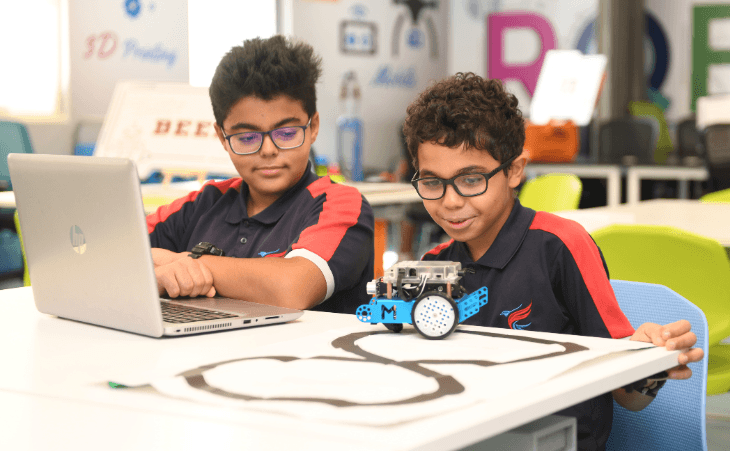

Education is a sector that must not only keep up with current developments but also adopt a futuristic approach in this world of innovation and technology that is constantly evolving. In recent times, the STEM (Science, Technology, Engineering, and Mathematics) Education System has become one of the most revolutionary methods to promote problem-solving, critical thinking, and experiential learning. For better preparation of students in the competitive and highly technological world, Indian CBSE schools are gradually incorporating STEM education into their curriculum.
This blog will take a closer look at the value of STEM education, how it affects kids’ academic performance, how it could support parents, and safety measures by teachers and parents.
Contents
What is STEM Education?
STEM education is an approach that unifies science, technology, engineering, and mathematics into a single, all-encompassing learning model and is simple to implement. STEM education, on the other hand, encourages the use of knowledge in the real world through problem-solving and the design of experiments that can be set up as students progress in an innovative manner. For instance, students of a CBSE school may come up with a simple Water Filtration System as part of a STEM project. A task like this demands they use scientific principles of purification, engineering skills for the design of the structure, mathematical calculations to measure quantities, and technology to enhance their project.
How can children benefit from STEM instruction?
STEM education improves learning experiences, makes them more adaptive and interesting, and prepares students for future careers in the following ways:
Improved Problem-Solving Skills: Students’ analytical thinking is developed through STEM-related projects. For instance, when students are working on robotics, they must troubleshoot coding errors. This encourages students to think creatively and solve problems. Enhanced Creativity: Students’ creativity is unleashed when they design experiments and models from scratch. A student making a solar-powered car, for example, combines science and engineering with innovative thinking.
More Engaging Learning: Participating in hands-on experiments makes learning more interesting. Math and science are more interesting to students when they can see and use real-world examples. Stronger Academic Performance – STEM activities reinforce theoretical concepts, helping students retain knowledge better.
Career readiness: STEM education ensures that students are future-ready with relevant skill sets as industrial work shifts toward automation, artificial intelligence, and data science.
How Can STEM Education Be a Helping Hand for Parents?
Parents often struggle or find it difficult to keep their children engaged with traditional academic methods. STEM education helps parents by:
Encourages Independent Learning – Instead of relying solely on teachers, students develop curiosity-driven learning habits.
Bridges Learning Gaps – Activities involving STEM allow children to learn through exploration, helping students grasp difficult concepts more efficiently and effectively.
Improves Relationship between Parent and Child – Parents can get actively involved in the field of STEM by participating in simple science experiments at home that strengthen their bonding with their children.
Fosters Core Life Skills –Such core life skills as teamwork, effective time management and resilience are enhanced through STEM activities.
Preparing Children for Competitive Exams – STEM education fosters logical reasoning, which is essential for exams like JEE, NEET, and Olympiads.
Precautions for Teachers and Parents to Take STEM education has several advantages and disadvantages. To ensure that learning is balanced, parents and teachers must take certain precautions: Age-Appropriate Activities: STEM activities should be appropriate for students of all ages without ever overwhelming them. Monitoring screen time: Although technology is essential to STEM education, excessive screen time can be disastrous, so this must be avoided. Safety in Experiments – Teachers and parents must be careful and supervise activities involving chemicals, electronics, or tools.
Encourage Curiosity but Avoid Pressure – Let children innovate and explore but do not burden them with unattainable expectations.
Facilitate gender-neutral participation by children in all STEM activities, free of stereotypes, by providing gender inclusivity. The future of learning is indeed in STEM education: it’s revolutionising CBSE schools by really promoting creative thoughts, problem-solving, and critical thinking in children. It equips children to face the real world and gives helping hands to parents in their educational journey so that learning is interesting and not something dry. STEM education has the potential to shape a whole new generation of thinkers and innovators if executed correctly and taken the necessary precautions.
Frequency Asked Questions
Q1: How to implement STEM education in Home Learning?
STEM activities can be introduced at home by parents. Activities like building simple machines, conducting kitchen experiments, or using educational STEM kits are available in the market.
Q2: Why is STEM education important for students?
The analytical and problem-solving abilities that STEM education generates are helpful in all fields such as humanities, business, and the arts.
Q3: Can STEM education be taken in a poor resource setting of a school?
Schools can start small by incorporating low-cost experiments, project-based learning, and digital resources like educational videos and simulations.
Q4: Can STEM education help students develop their personalities?
STEM encourages tenacity, teamwork, and communication skills. A group robotics project, for example, calls for cooperation, tolerance, and critical thinking.
Q5: Are the champions of STEM able to access scholarships or competition money?
Various forms of scholarships and accolades through different types of STEM events exist, including but not limited to the National Science Olympiad, Google Science Fair, and Atal Tinkering Labs.



